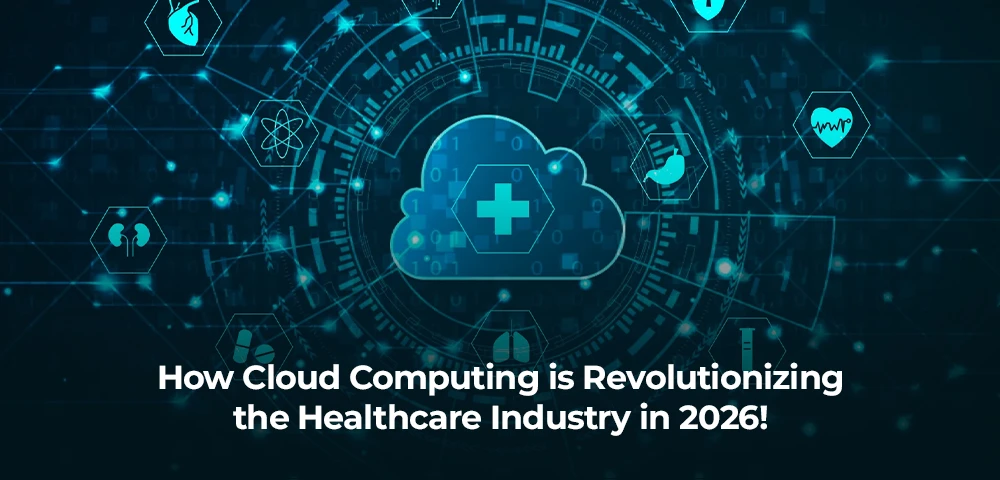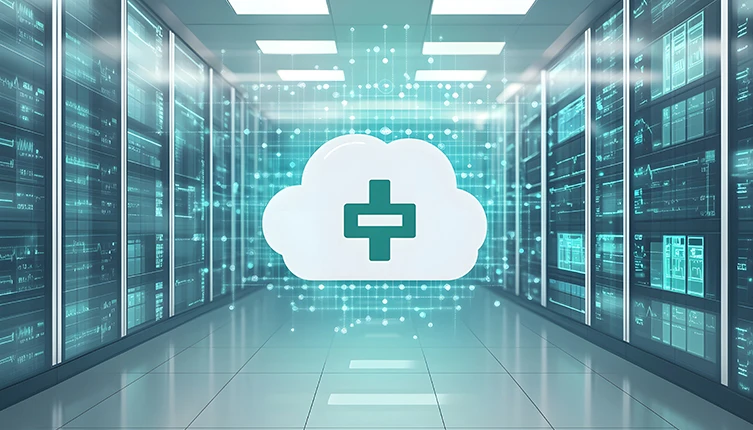
In 2026, cloud computing in healthcare is no longer a “nice to have” — it’s fast becoming mission-critical for hospitals, clinics, and healthcare systems around the world. From electronic health records (EHRs) stored in secure cloud environments, to AI-powered diagnostics, telemedicine, and scalable infrastructure, cloud technology is transforming healthcare delivery. In this article, we explore the trends, benefits, challenges, and future outlook of healthcare cloud computing, with tips to harness its power.

Key Trends Driving Cloud Adoption in Healthcare!
1. Explosive Market Growth & Demand
The global healthcare cloud computing market is projected to reach US$76.8 billion by 2026, growing at a compound annual growth rate (CAGR) of about 18.7%. This scale reflects increasing investments in cloud services, data storage, remote monitoring, and virtual care platforms.
2. Telemedicine & Virtual Care Expansion
Telehealth has surged thanks to cloud-based infrastructure. In 2026, we’ll see even more remote patient consultations, continuous monitoring via wearables and the Internet of Medical Things (IoMT), and cloud-hosted e-prescriptions. These improvements increase accessibility, especially in rural or underserved areas.
3. AI and Analytics on the Cloud
Cloud platforms now support massive compute power for AI-powered clinical decision support, predictive diagnostics (e.g. early detection of diseases), and real-time analytics. Machine learning models trained on large patient datasets and medical imaging are being hosted and processed in the cloud to reduce diagnostic errors and speed up treatment.
4. Scalability, Agility, and Cost Savings
Healthcare providers can scale cloud resources up or down depending on demand: during health crises, increased patient loads, or data spikes, cloud infrastructure flexes accordingly. This reduces the burden of on-site hardware, cuts IT maintenance costs, and enables faster deployment of new applications.
5. Enhanced Interoperability and Collaboration
Cloud-based EHR systems and shared data platforms promote interoperability among different hospitals, laboratories, and clinicians. Shared access to medical records, imaging, and test results in a cloud environment enables real-time collaboration and reduces duplication of tests.

Core Benefits of Cloud Computing in Healthcare
- Improved Data Access & Unified Records
With cloud-based healthcare solutions, patients’ medical histories, lab results, imaging data, and prescription records are accessible anywhere, anytime (with appropriate credentials). This reduces silos and improves decision making. - Cost Effectiveness
Cloud computing reduces the need for large upfront investment in hardware, data centers, and in-house servers. Subscription models (SaaS, IaaS, PaaS) allow pay-as-you-go, making healthcare cloud solutions more affordable and allowing resources to be directed where they matter most. - Better Security & Regulatory Compliance
While storing sensitive patient data in the cloud raises security concerns, major cloud providers offer robust security protocols: encryption (both in transit and at rest), role-based access control, HIPAA-compliant services, GDPR compliance, regular audits, etc. - Faster Innovation
Cloud platforms enable rapid deployment of new applications (telemedicine tools, AI diagnostics, data analytics dashboards). R&D and pilot projects can move from concept to deployment faster than with legacy on-premises systems.
Key Challenges & Risks to Address
- Data Security & Privacy Risks
Patient data breaches remain a top concern. Unauthorized access, cyber-attacks, and potential leaks are real risks. Ensuring privacy via encryption, access control, and compliance policies is essential. - Regulatory & Compliance Hurdles
Laws like HIPAA (USA), GDPR (Europe) and other regional regulations impose strict requirements on data handling. Cloud providers and healthcare organizations must ensure compliance to avoid fines and protect patient trust. - Integration with Legacy Systems
Many hospitals have older systems that are not cloud-ready. Migrating from legacy systems can be complex, risky, and expensive. Smooth integration requires planning, possibly re-architecting applications. - Reliability and Downtime
Cloud service outages or unreliable connectivity can impact access to critical patient data. Since healthcare is life-critical, downtime can have serious consequences. Backup plans, redundant systems, and vendor reliability are vital. - Skill Gaps & Operational Challenges
Skilled professionals in cloud infrastructure, cybersecurity, data privacy, and cloud-native application design are needed. Many healthcare organizations need to invest in training or partner with specialized vendors. Change management is also a significant factor.
Use Cases & Real-World Applications for 2026
- Hospitals and clinics using cloud-hosted electronic health record (EHR) systems that allow real-time updates, multi-facility access, and shared imaging (radiology, pathology).
- Remote monitoring via IoT devices (wearables, sensors) sending patient vitals to the cloud for continuous analysis (e.g. heart rate, glucose monitoring).
- AI tools hosted in the cloud that detect disease early (e.g. cancer, cardiac issues) by analyzing large datasets and imaging.
- Virtual care platforms enabling doctors to consult patients remotely, share medical records securely, prescribe medication, and follow up from home.
- Cloud-based revenue cycle and billing systems automating administrative workflows, reducing paperwork, speeding up claim processing.

The Future: What to Expect in 2026 and Beyond
- Hybrid & Multi-cloud Models
Many healthcare providers will adopt hybrid cloud (combining private and public clouds) or multi-cloud strategies to balance security, performance, and cost. - Edge Computing Integration
To reduce latency (critical in emergency care, imaging), edge computing will be combined with cloud to process data closer to where it is generated (ICU, ambulance, devices). - Advanced AI / GenAI Models
Generative AI (GenAI) will play larger roles — e.g. automated health coaches, AI assistant for clinicians, automated documentation, personalized treatment planning. - More Emphasis on Interoperability & Standards
Standardized data formats, APIs, sharing protocols will be more widely adopted to ensure that different systems can “talk” to each other securely. - Better Regulations & Global Standards
Governments and regulatory bodies will tighten laws around patient data, cloud provider accountability, transparency, and penalties for breaches. Compliance will be a core buying criterion for cloud solutions.
Recommendations for Healthcare Organizations
Practical, privacy-first steps to adopt cloud services while protecting patient data and continuity of care.
- Choose compliant cloud providers. Prefer HIPAA / GDPR-compliant vendors with proven security certifications and a history of healthcare deployments.
- Start small with pilots. Run pilot projects (EHR migration, telehealth) to validate workflows, performance, integrations, and user training before full rollout.
- Enforce strong access controls. Implement role-based access, encryption (at-rest & in-transit), multi-factor authentication, and comprehensive audit trails for patient data.
- Train staff proactively. Invest in regular training on cloud security, privacy regulations, and change management for clinicians and IT teams.
- Plan continuity & backups. Design disaster recovery and redundancy (failover regions, backups, RTOs/RPOs) to reduce downtime and protect patient care delivery.
- Monitor key metrics. Track latency, uptime, user satisfaction, cost savings, diagnostic accuracy impacting workflows, and security incident trends.
Conclusion
By 2026, cloud computing in healthcare will be deeply woven into how care is delivered. The promise of scalable, cost-efficient, interoperable, and secure healthcare cloud solutions is becoming reality. While challenges such as data privacy, regulatory compliance, and integration with legacy systems remain, organizations that navigate these wisely stand to gain improved patient outcomes, better operational efficiency, and greater agility. If your healthcare organization hasn’t planned for cloud adoption yet, now is the time. Embrace digital healthcare innovation, ensure health data security, and leverage cloud technologies to transform patient care in 2026 and beyond.
- How Cloud Computing is Revolutionizing the Healthcare Industry in 2026! October 1, 2025
- US IT Staffing 2025: Trends and Building Consultant Trust September 15, 2025
- Quantum Computing and AI: The Future of Technology Redefined March 20, 2025
- Cloud Cruising: Charting Your Certification Course Through the Skies of Cloud Computing February 19, 2025
- Problems Put Breaks To The Speed Of OpenAI’s Tool “Sora” January 7, 2025
